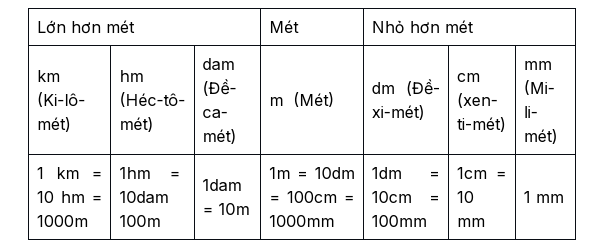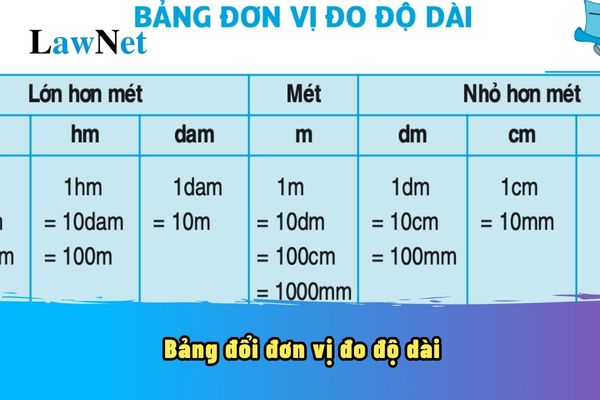What are details of the Table of Length Measurement Unit Conversion? When do students in Vietnam study the Table of Length Measurement Unit Conversion?
What are details of the Table of Length Measurement Unit Conversion?
The length measurement units include: Kilometer (km), Hectometer (hm), Decameter (dam), Meter (m), Decimeter (dm), Centimeter (cm), Millimeter (mm).
| 1 km = 10 hm = 1000 m | 1 hm = 10 dam = 100 m | 1 dam = 10 m | 1 m = 10 dm = 100 cm = 1000 mm | 1 dm = 10 cm = 100 mm | 1 cm = 10 mm | 1 mm |
*How to read and use the table:
Each cell: Each cell in the table shows the relationship between two measurement units. For example: 1 km = 10 hm means 1 kilometer equals 10 hectometers.
Conversion up: When converting from a larger unit to a smaller unit, you multiply by 10 or a multiple of 10. For example: To convert 2 km to meters, multiply 2 x 1000 = 2000 m.
Conversion down: When converting from a smaller unit to a larger unit, you divide by 10 or a multiple of 10. For example: To convert 500 cm to meters, divide 500 : 100 = 5 m.
Examples:
Convert 3 km to meters: 3 km = 3 x 1000 m = 3000 m
Convert 25 cm to dm: 25 cm = 25 : 10 dm = 2.5 dm
Convert 1.5 m to mm: 1.5 m = 1.5 x 1000 mm = 1500 mm

*Note: Information is for reference purposes only./.

What are details of the Table of Length Measurement Unit Conversion? When do students in Vietnam study the Table of Length Measurement Unit Conversion? (Image from the internet)
When do students in Vietnam study the Table of Length Measurement Unit Conversion?
According to Section 5 of the General Mathematics Program issued together with Circular 32/2018/TT-BGDDT, the requirements for the grade 1 Mathematics program are as follows:
*Measurement
Symbols for quantities and units of quantity:
- Recognize "longer," "shorter."
- Recognize the length measurement unit: cm (centimeter); read and write length measurements within 100 cm.
- Recognize that each week has 7 days and the names and order of the days in a week.
- Recognize the correct time on the clock.
Quantity measurement practice:
- Perform measurement and estimation of length using self-convention units (hand span, footstep,...).
- Perform length measurement using a straight ruler with cm as the unit.
- Accurately read the time on the clock.
- Determine the day of the week and date when looking at a calendar (daily page type).
- Solve some simple practical problems related to measuring length, reading time, and viewing calendars (daily page type).
Thus, according to the above regulation, grade 1 students have already recognized the length measurement unit in the required grade 1 Mathematics program.
What are the 3 objectives of the grade 5 mathematics education program in Vietnam?
Based on Section 1 of the General Mathematics Program issued together with Circular 32/2018/TT-BGDDT, the 3 objectives of the Grade 5 Mathematics education program include:
[1] Contributing to the formation and development of mathematical competence with the following requirements:
- Perform simple mental operations; ask and answer questions when reasoning, solving simple problems;
- Choose arithmetic operations and formulas to present, express (speak or write) ideas and methods for solving problems;
- Use mathematical language combined with ordinary language and physical gestures to express mathematical content in simple situations;
- Use simple tools and means for learning mathematics to fulfill simple mathematical tasks.
[2] Acquire basic initial and essential mathematical knowledge and skills about:
- Numbers and arithmetic: Natural numbers, fractions, decimal numbers, and calculations on those sets of numbers.
- Geometry and Measurement: Observe, recognize, describe the shape and features (at a perceptual level) of certain flat shapes and solid figures in practice; create some simple geometric models; calculate some geometric quantities; develop spatial imagination; solve some simple practical problems associated with Geometry and Measurement (with common measurement units).
- Statistics and Probability: Some elements of simple statistics and probability; solve some simple practical problems associated with certain elements of statistics and probability.
[3] Along with other subjects and educational activities such as Ethics, Nature and Society, Experiential Activities,… help students acquire initial knowledge about various professions in society.
What are regulations on development of the Grade 5 Mathematics Teaching Program in Vietnam?
Based on Section 2 of the General Mathematics Program issued together with Circular 32/2018/TT-BGDDT:
The Mathematics program strictly adheres to the fundamental regulations stated in the overall program;
It inherits and promotes the advantages of the current program and previous programs, selectively incorporates the experience of building subject programs from advanced countries around the world, and approaches the achievements of educational science, taking into account Vietnam’s economic and social conditions.
Simultaneously, the Mathematics program emphasizes the following perspectives:
- Ensure simplicity, practicality, modernity
The Mathematics program ensures simplicity, practicality, and modernity, reflecting the necessary content to be addressed in general education, meeting the needs to understand the world as well as the interests and preferences of learners, and aligning with the contemporary global approach. The program upholds the spirit of "mathematics for everyone," allowing everyone to learn mathematics but each person can learn mathematics in a way that suits their interests and individual capabilities.
The Mathematics program focuses on application, connecting with real life or other subjects and educational activities, particularly subjects aimed at implementing STEM education, aligned with the modern development trends of the economy, science, social life, and urgent global issues (such as climate change, sustainable development, financial education,...).
This is also reflected through practical activities and experiences in mathematics education with various forms such as: implementing learning topics and projects about Mathematics, especially those on the application of mathematics in real life.
Organize mathematics learning games, mathematics clubs, forums, seminars, mathematics competitions,... providing opportunities for students to creatively apply their knowledge, skills, and experiences in practice.

